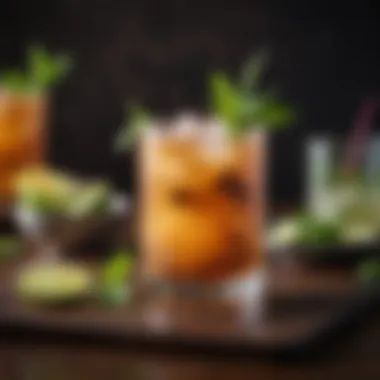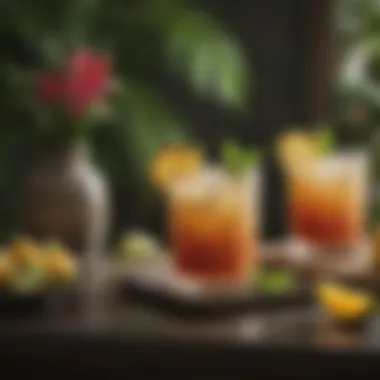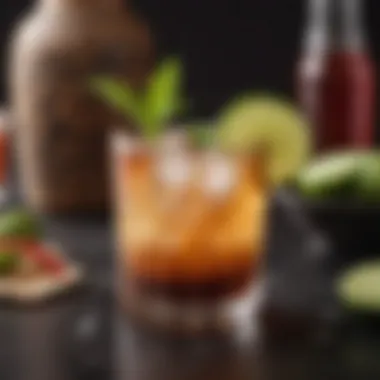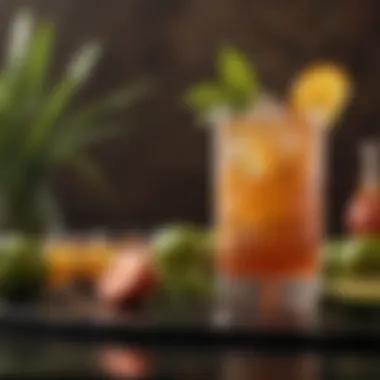Crafting the Perfect Mai Tai Cocktail


Intro
The Mai Tai cocktail stands as an enduring symbol of tropical flavor and skilled mixology. Originating in the mid-20th century, this drink has garnered fame for its complex flavor profile and vibrant appearance. Its combination of rum, citrus, and orgeat syrup creates a refreshing experience that transports the drinker to a sun-soaked paradise. Understanding the Mai Tai is more than just following a recipe; it's about appreciating the history and craftsmanship that goes into each glass.
In this article, you will explore the essential ingredients necessary for an authentic Mai Tai, along with various preparation techniques. You'll also learn about garnish options, which add a delightful touch to the cocktail's presentation. This guide aims to equip both novices and seasoned mixologists with the knowledge required to master the creation of this iconic beverage, while also noting variations that cater to diverse tastes.
Whether you're planning a casual gathering or a more sophisticated event, mastering the Mai Tai will elevate your cocktail skills and impress your guests.
Recipe Overview
Recipe Name and Description:
The Mai Tai is a classic cocktail that features a delightful blend of rums, citrus juices, almond flavoring, and a touch of sweetness. Often garnished with fresh fruit and mint, this drink embodies the spirit of tropical getaways and is perfect for any cocktail enthusiast.
Cuisine Type:
Primarily rooted in Polynesian and Caribbean influences, the Mai Tai is often associated with tiki culture.
Ingredients List
Detailed Ingredient Breakdown:
- Light Rum: This is the base spirit, providing a smooth and sweet foundation. Consider brands like Bacardi or Mount Gay.
- Dark Rum: Used for depth and richness, brands like Myers’s or Gosling’s work well.
- Lime Juice: Freshly squeezed lime juice adds necessary acidity, balancing the sweetness of the syrup.
- Orgeat Syrup: An almond syrup that gives the cocktail its distinctive flavor. Brands such as Monin or Torani offer good selections.
- Orange Liqueur: An orange-flavored liqueur like Cointreau or Triple Sec enhances the fruitiness of the drink.
Substitutions for Dietary Needs:
For those with nut allergies, consider using a different flavoring syrup, like simple syrup or ginger syrup, in place of orgeat. For a lighter option, a lower-sugar or diet-friendly rum can be chosen, without compromising the overall flavor too much.
By understanding the history and the components of the Mai Tai, you can create an authentic cocktail that reflects the original spirit of this timeless drink. Embracing these details will enable you to mix an exceptional Mai Tai that will be both satisfying and memorable.
Understanding the Mai Tai Cocktail
Understanding the Mai Tai cocktail is essential for anyone looking to appreciate not just the flavors, but the cultural and historical background of this classic drink. The Mai Tai stands out as one of the iconic cocktails, showcasing a blend of flavors which reflects its tropical origins. It is much more than just a beverage; it represents skillful mixology, rich traditions, and an array of ingredients harmoniously coming together.
Gaining insight into the history and cultural significance helps cultivate a deeper respect for the drink. It informs choices about ingredients and preparation techniques, crucial for achieving an authentic taste. A well-crafted Mai Tai tells a story—one that echoes the sun-kissed shores and vibrant festivities inherent in its birthplace.
Furthermore, knowledge about the Mai Tai equips enthusiasts with the ability to tailor their interpretations. This understanding allows for variations that cater to personal preferences, while still honoring the drink's foundational aspects.
History of the Mai Tai
The exact origins of the Mai Tai are often debated, but its roots trace back to the mid-20th century. The drink is most commonly attributed to Victor J. Bergeron, better known as "Trader Vic," who claimed to have first served it in 1944 in Oakland, California. However, some credit Donn Beach, founder of the renowned Don the Beachcomber bar in Hollywood, who reportedly made a similar beverage around the same time.
The name "Mai Tai" is thought to come from the Tahitian phrase "maita'i roa ae," meaning "good" or "excellent." This aligns with the drink’s qualities, offering a refreshing escape to tropical bliss. Over the decades, the Mai Tai evolved, influenced by the tiki culture that encapsulated the mid-20th century. Its popularity spread beyond California, capturing the fancy of cocktail enthusiasts worldwide.
Cultural Significance
The Mai Tai is emblematic of tiki culture, a phenomenon that gained traction in the United States during the post-World War II era. This period saw a surge in interest in Polynesian themes, with bars and restaurants embracing exotic decor, music, and cocktails. The Mai Tai became a symbol of leisure, escapism, and the laid-back lifestyle associated with a tropical paradise.
In addition to its role in popular culture, the Mai Tai has become a canvas for creativity among mixologists. The drink showcases a wide range of ingredients, from various rums to fruits and syrups, allowing for personalization. This adaptability is significant, as it reflects a broader trend in cocktail culture that values innovation while respecting tradition.
Overall, the Mai Tai not only serves as a delightful cocktail but also as a historical artifact, rich in stories and cultural resonance. Understanding its journey from inception to modern times enhances appreciation and inspires exploration in craft cocktail-making.
Core Ingredients
The essence of a Mai Tai cocktail lies in its core ingredients. These components not only determine the drink's flavor profile but also its authenticity. To create a well-balanced Mai Tai, it is crucial to select high-quality ingredients. Each element plays a specific role, and their interaction forms the backbone of this tropical classic.
Rum Varieties
Rum is the heart of the Mai Tai. A skillful mix uses multiple rum varieties to achieve depth and complexity. Typically, a blend of light and dark rum is recommended. Light rum contributes a smooth baseline while dark rum adds richness and body. Some enthusiasts also incorporate overproof rum for a more intense flavor and an elevated aroma.
When choosing rum, consider brands like Mount Gay or Rhum Saint James. They offer distinct characteristics suited for a Mai Tai. The geography of the rum influences its taste; for instance, Jamaican rums often have a heavier, sweeter profile than those from Puerto Rico.


Sweeteners and Syrups
Sweetness is vital in balancing the tartness of citrus and the strength of rum. Classic Mai Tai recipes often utilize orange curaçao and orgeat syrup. Orange curaçao brings a fruity note that complements the rum, while orgeat adds a touch of almond flavor and creaminess.
There are variations in sweeteners. Some people might prefer agave nectar or simple syrup for a more straightforward sweetness. Understanding the role of sweeteners can enhance the cocktail, and experimenting with different types can lead to a personal twist on the classic recipe.
Citrus Components
A Mai Tai gains freshness from citrus. Lime juice is essential; its bright and tangy flavor cuts through the sweetness and richness of the rum and syrups. Use freshly squeezed lime juice for the best result. It sharpens the taste and enhances the overall experience.
Some recipes include a dash of lemon juice, although this is less common. The key is balancing the citrus with the other ingredients. Too much acidity can overpower the drink, while too little can leave it flat.
Aromatics and Garnishes
A Mai Tai is not complete without its aromatic finish. Mint leaves are often used as a garnish, adding a fresh scent that enhances the tropical vibe. A slice of lime or a cherry can also provide visual appeal and add minor flavor notes.
Consider using a sprig of fresh mint. Gently slap it before adding to release its oils. This small detail elevates the cocktail's aroma significantly. Additionally, some might even add a touch of bitters to enhance the complexity of flavors, though this is more of a modern twist.
Preparation Techniques
In crafting an authentic Mai Tai cocktail, preparation techniques are crucial. These methods not only influence the taste but also affect the overall experience of enjoying this tropical drink. Understanding how to mix, shake, and build your Mai Tai will elevate your cocktail skills. Each technique has its own benefits and considerations that can fundamentally change the drink.
Mixing Basics
Mixing is the foundation of cocktail preparation. It involves combining ingredients in a way that ensures a harmonious blend of flavors. When preparing a Mai Tai, mix carefully to achieve the right balance between rum, citrus juices, and sweeteners.
- Importance of Precision: Use a jigger for accuracy in measuring your ingredients. The right proportions ensure that the drink is neither too strong nor too sweet.
- Incorporate Aeration: Proper mixing introduces air into the drink. This aeration can enhance the overall flavor and mouthfeel.
- Tempature Matters: Mixing ingredients at the right temperature influences taste. Consider chilling your glassware before serving.
Shaking vs. Stirring
The choice between shaking and stirring a Mai Tai can significantly impact its texture and taste.
- Shaking: This technique is best when using citrus juices. Shaking combines ingredients thoroughly and chills the cocktail quickly. The result is a frothy texture that many find appealing.
- Stirring: When using all spirits, like in certain variations of the Mai Tai, stirring gently preserves the clarity and smoothness of the drink.
"Shaking provides a more vibrant drink, while stirring delivers a refined experience that highlights the spirit’s character."
Understanding when to employ each technique is vital for achieving the intended flavor profile.
Building the Drink
Building the drink refers to the order and method of adding ingredients to create the final cocktail.
- Layering: Consider layering ingredients for visual appeal and to enhance flavor. Add denser components, like syrups, first, then pour more viscous liquids over them.
- Garnish Last: Always finish your Mai Tai with garnishes, such as fresh mint or a lime wedge. These not only add to the visual presentation but also enhance the aroma when consumed.
- Taste While Building: No cocktail creation is complete without tasting as you go. Adjust flavors gradually for balance.
By mastering these preparation techniques, you not only refine your Mai Tai but also elevate your mixology skills. Each step offers an opportunity to explore flavors and presentation, crafting a drink that reflects your unique taste.
Step-by-Step Mai Tai Recipe
The section on the Step-by-Step Mai Tai Recipe is pivotal in guiding readers toward the creation of this classic cocktail. Understanding the intricacies of making a Mai Tai transforms a good drink into a remarkable experience. This recipe serves as a roadmap for cocktail enthusiasts, offering clear instructions and valuabale insights. Not only does it cover the essential equipment required, but it also delineates the specific ingredient measurements necessary for a balanced taste.
Essential Equipment
To make the perfect Mai Tai, having the right tools is essential. The following equipment will streamline the preparation process and enhance the overall experience:
- Cocktail Shaker: A necessary tool for mixing the ingredients thoroughly, incorporating air and chilling the drink.
- Jigger: Used to measure precise amounts of ingredients, ensuring consistency in flavor and balance.
- Muddler: Essential for releasing the oils from citrus peels or herbs if you decide to add them for a twist.
- Strainer: Helps remove ice and any solid pieces when pouring the cocktail into the glass.
- Glassware: A rocks glass is ideal for serving a traditional Mai Tai, as it allows for an elegant presentation.
With these tools in hand, you can easily navigate the cocktail-making process.


Ingredient Measurements
The measurements for each ingredient are crucial to achieving the perfect balance of flavors in a Mai Tai. Each component plays a distinct role, contributing to the drink's signature taste. Here is a breakdown of the typical measurements:
- 2 oz. of Rum: A blend of light and dark rums works well.
- 1/2 oz. of Orange Curacao: Adds sweetness and depth.
- 1/2 oz. of Orgeat Syrup: This almond syrup brings a unique nutty flavor and creaminess.
- 1/2 oz. of Simple Syrup: Adjust based on personal sweetness preference.
- 1 oz. of Fresh Lime Juice: Ensure it is freshly squeezed for the best flavor.
Carefully adhering to these measurements will help you craft a well-balanced cocktail.
Detailed Instructions
Follow these detailed steps to prepare the Mai Tai:
- Chill Your Glass: Before starting, place your rocks glass in the freezer or fill it with ice water to chill. This keeps the cocktail cold longer.
- Mix Ingredients: In the cocktail shaker, combine the measured rums, Orange Curacao, Orgeat syrup, simple syrup, and fresh lime juice.
- Shake It Up: Fill the shaker with ice and shake vigorously for about 15 seconds. This not only chills the mixture but also blends all ingredients smoothly.
- Prepare the Glass: Remove your rocks glass from the freezer or empty the ice water. Fill the glass with crushed ice.
- Strain the Mixture: Using the strainer, pour the chilled mixture over the crushed ice, allowing it to fill the glass.
- Garnish Thoughtfully: Top with a sprig of mint or orange slice for visual appeal.
- Serve and Enjoy: Your Mai Tai is now ready to be enjoyed.
By following this step-by-step guide, you will create a beautiful and delicious Mai Tai. The clarity in instructions ensures that both novices and experts can replicate this classic drink with ease.
Remember, the art of mixology is all about experimentation, so feel free to adjust flavors to suit your palate.
Variations of the Mai Tai
Understanding the variations of the Mai Tai is essential for any cocktail enthusiast. The Mai Tai's rich history and versatility provide a foundation to explore diverse flavor profiles. Each variation presents an opportunity to cater to personal tastes, making the cocktail accessible to both purists and modern mixology fans. When one considers making a Mai Tai, it is not only about following a traditional recipe but also about improvisation and adapting to different contexts.
Classic Mai Tai
The Classic Mai Tai epitomizes the traditional approach to this cocktail. It is characterized by its balanced blend of light and dark rums, orange liqueur, orgeat syrup, and lime juice. The proportions matter significantly, as they create a unique yet straightforward taste. The original recipe, attributed to Victor J. Bergeron, emphasizes the importance of using quality rums. The Goslings Black Seal Rum and Appleton Estate Reserve are often favored for their robust flavors.
- Key ingredients:
- Light rum
- Dark rum
- Orange curaçao
- Orgeat syrup
- Fresh lime juice
The beauty of the Classic Mai Tai lies in its simplicity. However, one should avoid commercial sweet and sour mixers, as they dilute the cocktail’s authenticity. The proper technique is to shake the ingredients with ice and strain into a glass filled with fresh ice. A garnish of mint and a lime wedge enhances its visual appeal.
Modern Twists
Modern interpretations of the Mai Tai provide an exciting avenue for creativity and experimentation. Mixologists are inspired to introduce new flavors and ingredients that reflect contemporary palates. For instance, the addition of fruit juices such as pineapple or passion fruit can create a tropical twist that diverges from the classic.
- Common modern variations:
- Pineapple Mai Tai
- Spicy Mai Tai with jalapeño
- Tropical Mai Tai using coconut cream
In these variations, the initial spirit base remains constant, but the surrounding ingredients are creatively altered. Instead of orgeat, using almond milk can soften the flavor, allowing for a different texture. These variations can add a fun and refreshing element, making the Mai Tai relevant in modern cocktail culture.
Tropical Alternatives
Tropical alternatives to the Mai Tai broaden the experience for cocktail lovers. These drinks often pay homage to the Mai Tai while incorporating other tropical elements. Consider mixing in flavors like coconut, mango, or even hibiscus. These variations often appeal to those who enjoy fruity cocktails.
- Examples of tropical alternatives:
- Mango Mai Tai with fresh mango puree
- Coconut Mai Tai featuring coconut rum
- Hibiscus Mai Tai, incorporating hibiscus syrup
The tropical flourish enhances the drink's character without overshadowing the foundational spirit base. There is flexibility in garnishes, which can include fresh fruit or edible flowers, aligning with imaginative presentation standards.
"Every sip of a Mai Tai variation tells a story of adaptation and personal taste."
"Every sip of a Mai Tai variation tells a story of adaptation and personal taste."


In exploring these variations, one gains a profound appreciation for the Mai Tai's rich legacy. The variations enhance the cocktail's charm, inviting enthusiasts to explore and discover their preferred interpretation. Crafting different styles of the Mai Tai encourages experimentation, which can lead to greater enjoyment and personal connection with the drink.
Serving Suggestions
Serving suggestions can significantly enhance the Mai Tai cocktail experience. It is not just about making the drink; presentation and pairing elevate its appeal. When hosting gatherings or events, how you serve a cocktail can influence the overall vibe. A well-chosen glass, suitable garnishes, and complementary foods transform a simple drink into a memorable experience.
Glassware Options
The choice of glassware is crucial when serving a Mai Tai. Traditional options are typically tiki mugs or highball glasses. These vessels not only hold the drink but also contribute to the aesthetic. Tiki mugs, with their unique designs, nod to the tropical heritage of the cocktail. They are typically large, allowing for generous portions and garnishing. Highball glasses can create a more contemporary look, ideal for casual settings.
Additionally, consider the size and shape of the glass based on the drink's appearance. A taller glass can create layers in the presentation, while shorter ones may offer a more concentrated look. To enhance the visual appeal, consider using glassware with vibrant colors or patterns. A thoughtful selection can resonate with the Mai Tai's lively character.
Pairing with Foods
Pairing food with a Mai Tai creates a cohesive dining experience. The rich flavors in the cocktail, which include sweetness and citrus, work harmoniously with various dishes. Here are some suggestions:
- Spicy Asian dishes: The sweetness of the Mai Tai can counterbalance the heat, creating a less intense experience while allowing flavors to shine.
- Grilled seafood: Dishes like grilled prawns or fish tacos complement the tropical theme of the drink and highlight its citrus notes.
- Fruits: Fresh fruit platters with mango, pineapple, or coconut can enhance the tropical essence.
- Tropical ceviche: This dish's acidity and freshness align well with the tangy components of a Mai Tai.
When serving food alongside the cocktail, consider the balance of flavors. Aim for contrasts that enhance the drinking experience. Combining complementary tastes and textures will not only please the palate but also enrich the gathering's atmosphere.
Expert Tips for the Perfect Mai Tai
Crafting the perfect Mai Tai goes beyond just following a recipe. Understanding the nuances can elevate the cocktail experience substantially. This section provides insights and practical advice to enhance your Mai Tai-making skills. By focusing on specific elements such as ingredient quality, flavor balance, and presentation, one can create a Mai Tai that is not only refreshing but also sophisticated.
Use Quality Ingredients
The foundation of any great cocktail lies in its ingredients. When it comes to the Mai Tai, using quality rum is paramount. Opt for a blend of a light rum and a dark rum, as they each contribute uniquely to the drink's profile. Look for rums with a proven reputation, like Appleton Estate or Hamilton, which offer rich flavors and aromas.
In addition to rum, fresh citrus juice is essential. Squeezing fresh lime juice is necessary for the right acidity. Say no to bottled juices, as they often contain preservatives that can alter the taste. The same principle applies to sweeteners; consider using natural, authentic cane sugar syrups. They generally have a more complex flavor than commercial options.
Balance Flavor Profiles
The Mai Tai is a complex cocktail that requires careful attention to its flavor components. Balancing the sweetness from syrups with the acidity of lime juice creates harmony. It is crucial to experiment with the ratios. A good starting point could be 1.5 ounces of rum, 0.75 ounces of lime juice, and 0.5 ounces of orgeat syrup.
Another aspect of balancing flavors includes selecting the right amount of aromatics. A touch of orange liqueur can add depth, while the toasted almond notes from orgeat enhance the cocktail's richness. Tasting as you mix will help determine if adjustments are needed to achieve a well-rounded drink.
Presentation Matters
A Mai Tai is not just about taste; it is also about visual appeal. Serving it in the right glass can elevate the experience. Traditional tiki mugs or a rocks glass can complement the drink’s vibrant colors.
Garnishing also plays a vital role. Fresh mint, a slice of lime, or even a small paper umbrella can add the finishing touch. Don’t forget to consider the texture of your garnish. A sprig of mint not only adds visual flair but also provides an aroma that enhances the drinking experience.
"A well-crafted Mai Tai is a feast for the senses, engaging not only the palate but also the eyes and nose."
The End
The conclusion of an article on the Mai Tai cocktail serves as a vital synthesis of the information covered. This section reinforces the importance of understanding the cocktail's elements and preparation methods. Here, we summarize key points and highlight how they contribute to crafting an authentic drink. By revisiting essential aspects, readers can better appreciate not just the Mai Tai's flavors, but also its rich cultural backdrop.
Recap of Key Elements
A successful Mai Tai is more than just a drink; it embodies the harmonious blend of high-quality rum, citrus, sweeteners, and aromatics. Each ingredient plays a critical role:
- Rum Varieties: A mix of light and dark rums creates depth of flavor.
- Sweeteners and Syrups: Orgeat syrup adds nuttiness while orange liqueur offers sweetness.
- Citrus Components: Fresh lime juice is essential for balance and brightness.
- Aromatics and Garnishes: A sprig of mint or an orange slice enhances the cocktail's visual appeal.
Understanding these elements is essential for mastering the Mai Tai. Knowledge of the cocktail's history and variations further enriches the experience for those preparing it.
Encouragement to Experiment
Crafting the Mai Tai gives room for personal interpretation. While adhering to classic recipes can yield a fantastic drink, it is beneficial to explore individual preferences. Substituting different rums, sweeteners, or garnishing methods can lead to exciting outcomes.
Many enthusiasts have developed unique twists on this cocktail, incorporating local ingredients or adding new flavors. This encourages a sense of creativity and innovation in mixology. Therefore, readers should not hesitate to try new approaches. Your own Mai Tai may just become the highlight of your next gathering.
"Food and cocktails are about bringing people together, and experimenting in the kitchen or at the bar is part of the joy."















